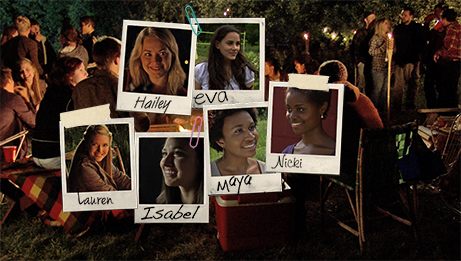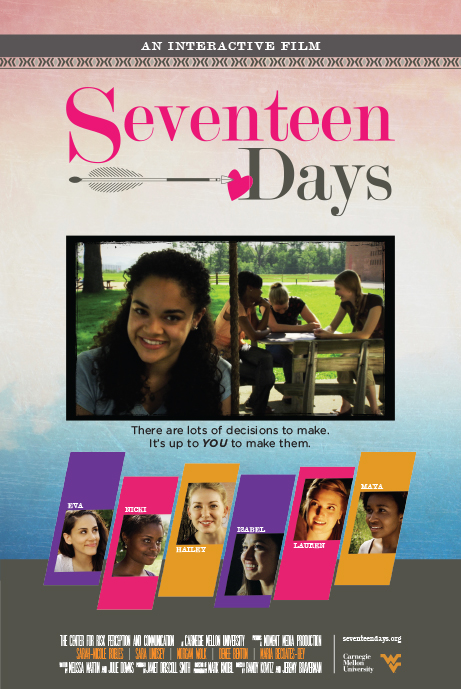Training
Upcoming Webinars:
April 23rd at 1pm EST
May 23rd at 10am EST
June 24th at 1pm EST
Please contact [email protected] if you are interested in attending an upcoming webinar.
The cost is $300 per person which includes an eLearning course and a 1.5 hour webinar.
Training through Carnegie Mellon University is the only approved training for Seventeen Days and is required to implement the program.
Seventeen Days collaborated with dfusion to provide training to maximize the benefits of the video and the accompanying Educator Portal.
Materials
This information is copyrighted, if you want to use these materials please request information from [email protected]
Seventeen Days Handout for core dosage requirement.
Admin Tools
Administrative Portal Guidebook (copyrighted material)
Seventeen Days DVD UserGuide (copyrighted material)
Seventeen Days Fidelity Monitoring Tool
Seventeen Days Logic Model
Seventeen Days Discussion Guide
Promote the Program
Activation Code Tear-Off Label
Seventeen Days Flyer
Seventeen Days Poster
Awards
Seventeen Days and Your Move Awards
Frequently Asked Questions
Questions from participants
How long is the video?
It all depends on the viewer. In the first viewing, Seventeen Days is designed to be about 55 minutes, but there are more stories to watch and extra videos available from the menu with over 3 hours of content available. You can watch for as much or as little as you want.
How many stories am I able to watch?
In the initial viewing, viewers choose one story. In later sessions, by choosing “Back for More” on the main menu screen, viewers can access the stories of the remaining five girls as well as additional information on contraception, visiting the gynecologist, and a review of the condom demonstration.
Is there a correct answer?
There are no correct answers. Within each story, viewers are prompted to make choices about what they want to see the character do next, with three different options. The scene will resume following whichever option was chosen, so just pick whichever one you want to see.
What should I do when it asks “What could you do?”
These prompts are meant to encourage viewers to pause and consider how they would react and how they could change their responses for the better. The video is asking viewers to imagine a similar situation happening in their own lives, and think about how they would handle it. Thinking about it in advance and practicing what to say makes it easier to do it when the time comes.
I have watched everything. What should I do next?
We encourage viewers to revisit the material periodically to reinforce the risk reduction strategies and broader lessons learned. Additionally, you may wish to share the information with others who may benefit from it.
How can I show this to my siblings or friends?
Seventeen Days is available by purchasing the DVD or online licenses. Visit the Get It Now tab on our website for more details.
Questions from parents
Does the video show people having sex?
No, the video does not show sexual behavior. However, it strongly suggests that sexual behavior is about to occur, and includes some language and behavior suggestive of sex such as intimate kissing and removal of clothing.
What is the science behind this?
Seventeen Days is based on extensive research about how female adolescents make decisions about sexual behavior. It includes scientifically supported techniques for reducing risky behavior, including behavioral modeling to demonstrate safer behaviors, cognitive rehearsal to mentally practice making safer choices, and risk reduction approaches to understand how and why risk may be reduced by making changes in behavior. Additionally, the video addresses common misconceptions about sexual health to help improve understanding.
Why are you doing this?
Adolescents are at high risk of pregnancy and STI infection, due in part to limited disease knowledge, condom failures, and perceived lack of control over sexual decision making with male partners. Seventeen Days is designed to reduce these risks.
Questions from clinics and community partners
Does the video show contraceptives?
The video shows and explains multiple contraceptive options, including condoms as well as hormonal birth control including the pill, the IUD, and Depo-Provera shots. It also shows a visit to a gynecologist and how to get birth control.
What are viewers required to do?
Viewers are only asked to watch the video and make choices on screen when prompted. There is no additional material.
What is the target population for this program?
This intervention is targeted at young women aged 14 to 19, which is a time when they are highly likely to be facing decisions about sex. The video was designed for young women who are already engaged in or contemplating sexual behavior.
How long does it take?
Seventeen Days is designed for an initial viewing time of approximately 55 minutes. There is over three hours of interactive material available, and subsequent viewings may vary widely depending on the viewers’ interests and the number of scenarios watched. The ideal program dosage includes a baseline visit (55 minutes), and a monthly booster session to view one additional vignette and one of the mini documentaries (10-20 minutes each).
Can participants complete the intervention in groups?
Seventeen Days was designed as an individual-level intervention for several reasons. First, it uses interactivity to self-structure to the viewer’s needs based on the choices that the viewer makes. Second, it presents material and asks the viewer to participate in ways that might create embarrassment in front of peers. Third, it includes cognitive rehearsal to reinforce lessons, and relies on the screen pausing with viewer attention to engage the audience and lead to more involved mental practice. There may or may not be benefit to be gained from viewing portions of the Seventeen Days materials in groups, to augment the individualized participation, but the program has not been assessed in that context.
Can I review the content before using the video?
Please contact the developers at [email protected] to request a sample DVD or a temporary activation code to view prior to purchase. Once purchased, it is a good idea to encourage all personnel who will be promoting the program to first view it themselves. However, if the program will be compared to another intervention or to a control condition for research or evaluative purposes, we strongly advise blinding recruiters, evaluators, and clinicians to participants’ study condition to minimize bias.





